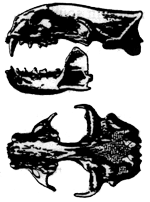Otter
A quick look at the fossils preserved at Hagerman Fossil Beds quickly reveals that many of the species have modem relatives associated with wetland or aquatic environments. Fossilized bones of frogs closely related to the living leopard frog are quite abundant, as are pieces of shell of two different species of turtle. Most of the bird fossils found are waterfowl such as swans, ducks, geese, grebes, pelicans and cormorants. Likewise, aquatic mammals including beaver, muskrat and otter are frequently encountered. Although there are many non-aquatic species such as the horse, camel, ground sloth and peccary, there is no question that among the many types of fossil species found at the Monument, the fauna is dominated by aquatic forms. This data indicates that 3.5 million years ago this part of Idaho was much wetter and had considerably more wetland habitat then exists in the area today.
Although the overall amount of wetland habitat in southern Idaho today is less than in the past, the Snake River and associated wetland areas around the Hagerman Valley provide suitable habitat where many aquatic species can be found. One of those aquatic animals that can be seen on occasion is the river otter. Unlike the beaver, in which the fossil species found at the Monument is almost identical with its modern descendant, the fossil otter at Hagerman and the modern otter found along the Snake River today are different and represent two different groups of otters, one originating in the old world and one in the new. The modem river otter, Lutra canadensis, is closely related to the otters of Europe and did not appear in North America until about 1.9 million years ago. Our Hagerman otter. Satherium piscinarium, is part of a New World lineage and is closely related to the giant otter found in Brazil and other parts of tropical South America and in fact may be its ancestor.
Otters are members of the carnivore family Mustelidae, which also includes skunks, weasels, wolverines and badgers. Most members of this group are carnivorous or sometimes omnivorous and the otter is no exception. except the otter catches most of its prey in the water. The living river otter eats fish. frogs, crayfish and freshwater clams and our fossil otter probably had similar habits. One major difference of these otters is in the teeth. In Satherium they are broad and seem better suited for crushing rather than shearing food.
It is likely that the diet of the fossil otter at Hagerman included a higher percentage of freshwater clams and crayfish than the modern river otter. since these broader teeth would be useful for cracking shells. The Hagerman fauna includes a variety of freshwater clams and snails including a large freshwater mussel called Anodonta. Quite abundant as a fossil in the sediments. Anodonta would have provided a ready food source for the otter. Another item on the otter's menu, crayfish, have been found as fossils elsewhere in the Glenn's Ferry Formation but only indirect evidence of their presence on the Monument is available. This evidence for their presence in the Monument includes gastroliths (these are nodules of calcium minerals formed in the stomach of a crayfish resulting from the resorption of calcium salts from its exoskeleton when it is getting ready to molt), and by the presence of what are believed to be traces of their burrows preserved in some sedimentary layers.

Otters are distinguished from other mustelids by the modification of their skeleton for swimming. A nearly complete skeleton of Satherium collected by the Smithsonian shows that, like living otters, it was well adapted for life in the water. In many swimming mammals, including the otter, the femur (upper leg bone) is short and stout and the tibia (larger of the two lower leg bones) is long. The tail is long and muscular and along with the hind legs helps to propel the animal through the water. The skeleton of Satherium has all of the features one would expect to see in a strong swimmer. These features, along with the structure of the skull and teeth, support our interpretation that Satherium like the modern river otter could maneuver in the water to catch fish, frogs and crayfish or uncover freshwater clams hidden in the mud.
Most of our knowledge of the extinct otter at Hagerman is based on the discoveries made by the Smithsonian and the University of Michigan. Field work at Hagerman by the National Park Service since the Monument was established has resulted in the discovery of a few pieces of otter which are now in the Monument's collection. Perhaps the discovery of additional material will help us to better understand the ecology of this extinct species and answer a number of questions such as: was its extinction due to competition with the river otter when it entered North America or how closely is it related to the Brazilian giant otter?
Perhaps Satherium is not really extinct, but still lives on in South America as the giant river otter.